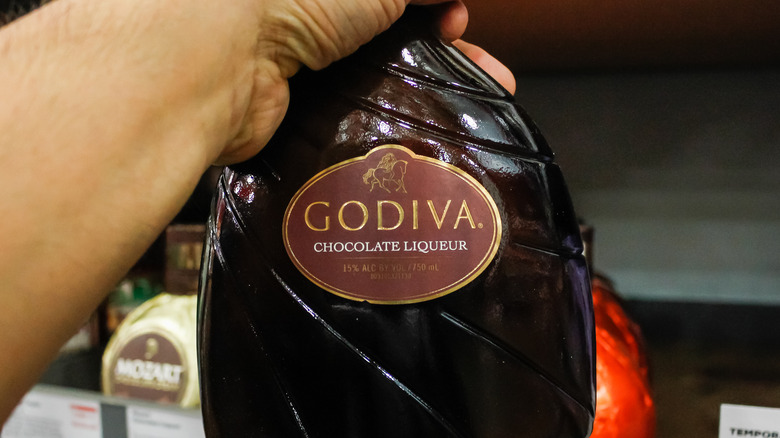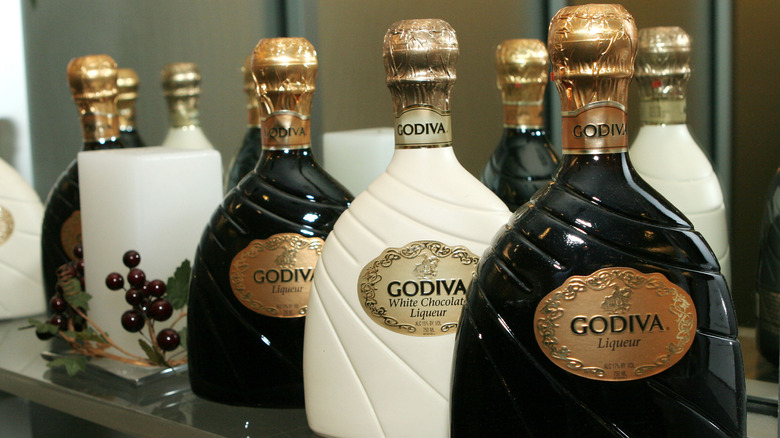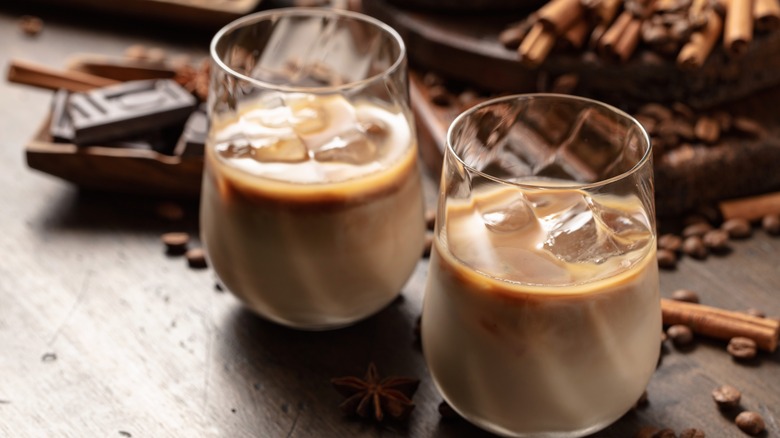What Type Of Alcohol Is Used In Godiva Chocolate Liqueur?
We may receive a commission on purchases made from links.
It's no wonder Brussels, Belgium, is referred to as the "World Capital of Chocolate" (per The New York Times). According to Neuhaus Chocolates, this luxurious legacy began when Jean Neuhaus Junior manufactured and sold the world's first praliné in 1912 in Brussels. This chocolate was the first of its kind to encapsulate a nougat or ganache filling within a hardened shell, turning a bitter burden into a tempting treat. Neuhaus Junior got the idea from his grandfather, Jean Neuhaus Senior, a pharmacist who used chocolate as a medicinal encasing that masked the pungent taste of pharmaceuticals.
Then, in 1926, the chocolate frontier changed yet again with Chocolaterie Draps, a Belgian chocolate supplier owned and operated by the Draps family. Chocolaterie Draps soon changed to Godiva after the legendary Lady Godiva, whom Pierre Draps and his wife admired, per the company's website. This Anglo-Saxon woman boldly and courageously rode nude on horseback through Coventry, Warwickshire, to persuade the Earl of Mercia (her husband) to reduce the people's tax burdens, via Britannica. Spoiler alert: it worked.
Today, Godiva is one of the world's largest chocolate manufacturers and is still based in Brussels, Belgium. The company is known for its velvety chocolate pralinés, renowned truffles, aromatic coffee, and — as of the early 1990s — its chocolate liqueur. But what exactly is this liqueur made of, and why has it been kept such a secret?
Godiva's liqueurs: Milk, white, and dark chocolate
The truth is, unless you are a Godiva Chocolatier, nobody knows what spirits truly make up Godiva chocolate liqueur. While their individually wrapped chocolates may be detailed on biscuit boxes, there isn't much insight into the alcohol that concocts the liqueur. According to The Spruce Eats, it is assumed that it is most likely produced from a mild vodka-like spirit made from grain that lacks a bold or sharp taste. And, because Godiva uses high-quality ingredients to craft their chocolates, this makes their liqueur equally smooth — almost silky — with a resting ABV of 15%.
Throughout the liqueur's early days, Godiva dabbled with many flavors. These included caramel, mocha, and cappuccino. However, their success did not last long. Godiva eventually settled on three universal flavors: white, dark, and milk chocolate — the foundation and starting point for Godiva's liqueur. While this creamy spirit tastes like a liquified chocolate bar, Godiva's dark and white chocolate compete in another arena. According to Drizly, the dark hints at cherry, orange, and coffee notes, whereas the white has a more vanilla and sweetened profile. Still, all three are perfect in a martini, on top of a bowl of ice cream, or paired with freshly baked Godiva cookies.
There's a difference between 'liquor' and 'liqueur'
Not to be confused with general liquor (think tequila, gin, rum), Masterclass reports that a liqueur is a liquor that has been sweetened by additives and additional ingredients. In this case, it's Godiva chocolate. These flavors remove the bitter tastes associated with based liquors and make them smoother, more rounded-out spirits. Liqueurs, like Bailey's Irish cream, Kahlúa, and Godiva, are often used in after-dinner drinks where a rich and often sweeter profile is desired.
According to Britannica, liqueurs were historically made from plants or fruits and used as potions, medicines, and — much like chocolate — pleasurable stimulants. They were most likely introduced by monks and alchemists. In the end, these added flavors mute the original fermented and distilled liquors, creating a unique and palatable drinking experience.
Apart from liqueur, other chocolate spirits exist as well. Chocolate rum, like Bruno Mars' SelvaRey, has won many awards since its introduction as a chocolate-infused rum that's been aged for five years. Its most notable award was the Chairman's Trophy at the Ultimate Spirits Challenge. SelvaRey made history as the first flavored liquor to take home the crown in 2014. Whether you go for chocolate liqueur, chocolate rum, or another chocolate-infused spirit, your sweet treat can be enjoyed on the rocks, chilled, or mixed into your favorite cocktail.


